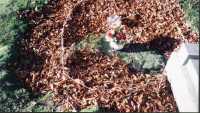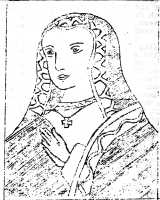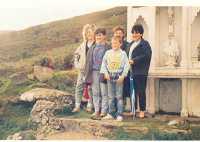Welcome to Killeavy.com
Saint Monnina is the patron saint of Upper and Lower Killeavy; she lived in the years 435 to 518. Her father was Machta king of the territory, stretching from Louth to Armagh. Her mother was Comwi, daughter of one of the northern kings. It is related that Saint Patrick passing through the lands of Machta, paid him a visit. He blessed his wife and little daughter baptising her by the name of his own sister, Darerca. He prophercied to the parents that the name of the child would long be remembered.
That name has many different forms. It appears her pet name was “Blinne” or “Moblinne”. Baby but in later life she went as a missionary to England and Scotland, to places where various dialects were spoken, and people adapted her name to their own speech. Thus in Scotland her name became Edanna, Edan, Edin. A famous Scottish historian, F. Skene, about a century ago, stated that the city of Edinburgh grew from a settlement near the convent of the Irish nun Edin, or Modena. The old name of Dunedin was anglicised to Edinburgh.
The picture shown here is taken from the big window, of an old church near Hanley, in Staffordshire. Before the so-called Reformation, she was revered in this region. Here the name was Modyn, Modym, Modena, even Mud. St. Mud's Hole is a holy well, near Burton-upon-Trent. It was here she founded a large convent and had her headquarters for evangelising the district, Churches were dedicated to her, and the Protestant church in Burton still bears her name.
Moninna had a younger brother, Ronan, also a missionary. He became a bishop and was the abbot of Luncarty, near Dundee in Scotland. When Moninna had worked for seven years in Staffordshire, Saint Patrick, directed her to Scotland. Here she paid a visit to her brother, and then, continued her work of spreading the Gospel, and founding communities of nuns, who tended to the sick and the poor. In Scotland she built churches in the name of Christ. A 12-century writer gives us a list and he writes: "She had also been to Albainn, that is Scotland, where she had built churches in the name of Christ. These are their names. One is in Chilnecase (now Whithorn) in Galloyway. Another is on the summit of the hill, which is called Dundeneval (now Dundonald, because it was always her custom as we have said earlier, to pray at night, with bare limbs on bare rock to God.... A third is on another hilltop, Dumbarton. A fourth is in a fortress called Stirling. Yet a fifth is in Dunedin. which in the language, of the English is called Edeneburg. A sixth is the hill of Dunpeleder, now Traplain Law and there she crossed the sea, into Albainn, to Saint Andrews. Then after this she went to Alyth, where there is now a fine church, which she built, with a very holy spring at Luncarty and she stayed there some time. She greatly loved that place- where at the end of her life, she breathed her last.

St Moninna's grave in the Killeavy Graveyard
On the northern side of the cemetery there is a very large granite stone measuring seven feet long, five feet wide and about one and a half feet thick. This stone covers the supposed grave of St. Monnina - who died in the year 518 and here in days when the Pattern (which was the anniversary of the day on which a church had been dedicated to a saint) was celebrated, prayers were said at this spot and the pilgrim continued to her Holy Well further up the mountain, returning to this gravestone for the final prayer. The Pattern Day of St. Moninna was 6th July, but with the coming of persecution to the Catholic faith, these religious ceremonies were banned by law. The Pattern was revived in the year 1928 and seems to have survived until 6th July 1934. The scene was an historical setting for the Holy Year Pilgrimage on 4th August 1974. After the suppression of the Pattern in 1825, the existence of the Holy Well was forgotten about but was re-discovered by Father James Donnelly C.C. Meigh in 1880. The inscription on the Shrine at the Well now reads "Tobar Naoimh Blathnaidh - A.D. 498 - 1829".
A few locals up at St Moninna's Well on the sloops of Sleave Gullion

















